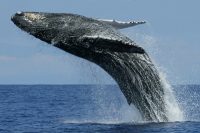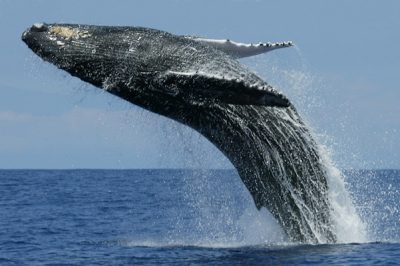Blue whale (Balaenoptera Musculus) is by far the largest animal in the world that has ever lived on this planet. It is so huge that the weight of its tongue (5,400 pounds) is equal to that of an elephant. It is a marine mammal and also one of the 15 species of baleen whales. Baleen whales are filter-feeders and they filter out food by means of baleen plates fixed on their upper jaws.
Blue whale is a solitary animal. It has a long slender body with a U-shaped head. It appears to have a mottled bluish-gray look as it comes out of water. Its underbelly is pale yellow to white. It has two blowholes. The vertical spout of a blue whale can be as high as 30 feet.
The size of a blue whale can range from 82 to 105 feet and weighs up to 400,000 pounds. However, normally it weighs around 90,000 to 272,000 pounds. The size of a newborn is 25 feet and weighs around 6,000 pounds. The size of its heart is the largest for an organ of any animal in the world. It weighs around 400 pounds. The length of flippers is 10 to 13 feet while its dorsal fin varies between 20 to 40 centimeters.
On average, it has a lifespan of 80 to 90 years. It is one of the loudest and longest-lived animals on earth. Its groans or pulses can be heard from miles away. The age of the oldest blue whale ever recorded is about 110 years old.
It reac hes maturity at the age range of 5 to 10 years. Mating occurs between late fall and winter. A female blue whale gives birth to newborns after 2 to 3 years and nourishes them for 6 months. A calf of a blue whale gains about 200 pounds of weight each day.
hes maturity at the age range of 5 to 10 years. Mating occurs between late fall and winter. A female blue whale gives birth to newborns after 2 to 3 years and nourishes them for 6 months. A calf of a blue whale gains about 200 pounds of weight each day.
Blue whales were widely distributed across all oceans of the world before whaling (hunting of whales) in the twentieth century. Today, they are found in the Northern parts of the Atlantic and the Pacific as well as the Southern Hemisphere.
Despite its huge size, the diet of a blue whale consists mainly of tiny organisms. But tiny creature ‘krill’ forms the main component of its diet. It is observed that every day a blue whale eats about 4 tons of krill. Occasionally, it also feeds on other small animals like copepods.
During 60 years (1900 – 1960), almost 360,000 blue whales were killed for the sake of getting oil from it.
During short bursts, it can cruise at a speed of 31 mph. Typically, it maintains a speed of 12 mph but decelerates to 3.1 mph during eating. The recorded depth at which blue whale plunged under the ocean is 1,660 feet.
Killer whale is the only natural predator of blue whales.





